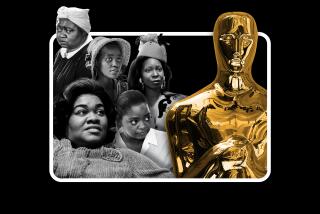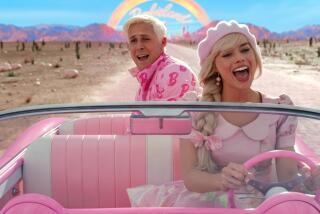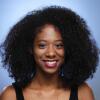‘Not So Silver Screen’ panel will explore erasure of black women in entertainment
Halle Berry was the first — and only — black woman to win lead actress at the Oscars.
She took the stage to accept the award for her role in “Monster’s Ball” in 2002 — almost 40 years after Sidney Poitier became the first black man to take home the lead actor statue in 1964 — visibly overcome with emotion, thanking her forebears at the top of her speech.
“This moment is so much bigger than me,” she said. “This moment is for Dorothy Dandridge, Lena Horne, Diahann Carroll. It’s for the women that stand beside me: Jada Pinkett, Angela Bassett, Vivica Fox. And it’s for every nameless, faceless woman of color that now has a chance because this door tonight has been opened.”
It is those nameless, faceless women of color who are the inspiration behind a March 30 panel at the Hammer Museum. Part of the museum’s Bureau of Feminism initiative, “The Not So Silver Screen: Black Women in Media” will examine the “invisibility and devaluing of black women in media,” the wage gap for black women in the entertainment industry and solutions to help promote black women as creators.
Panelists include actresses Carroll (“Dynasty”), Tonya Pinkins (“All My Children”), and LisaGay Hamilton (“The Practice”), casting director Twinkie Byrd, culture critic April Reign (who started the “OscarsSoWhite” campaign last year), professor Kristen Warner of the University of Alabama, and it will be moderated by Kimberlé Crenshaw, a law professor at Columbia University and UCLA.
The Times caught up with Crenshaw to discuss the gains made by black actresses and creators in recent years and the work left to do to make the silver screen a more inclusive place for black women.
With the increased visibility of entertainers like Issa Rae, Shonda Rhimes, Ava DuVernay and others, where do you think we stand today in terms of visibility for black women?
I think that we have made a lot of strides, but even with that visibility, black women are underrepresented relative to their viewership, relative to their representation in the overall population. A few breakouts suggest that change is possible, but we’re interested not just in thinking about this issue in terms of breakout actors and actresses but also being able to represent and tell stories about life from perspectives that we have not yet seen regularly in the media.
What kind of stories do you think still need to be told?
Basically, what’s happening in media is both a reflection of our society and it also reinforces the assumption that these issues don’t necessarily impact black women directly or that if they do, we don’t need to tell stories and imagine life from their point of view. So black women are stuck in the imaginaries of the men in their lives, they’re stuck in the imaginaries of white writers, they’re even stuck in the imaginaries of white women. Part of what we want to talk about is what happens when black women can imagine themselves and tell stories from their own vantage point. And what role and what space black women might occupy in Hollywood [then].
Why is it so easy for the narratives of black women to fall through the cracks?
Well, that’s a question I’ve spent 30 years trying to figure out how to answer [laughs]. It is a reflection of how black women are imagined in lots of different spaces. One of the things that made [“Hidden Figures”] so exciting was that finally a story of discrimination was being told from a woman’s perspective, from a black woman’s perspective. You just don’t have that happening because race tends to be imagined from a male perspective. The same with respect to white women [being the perspective from which gender is imagined].
So you know, Hollywood isn’t going to be that different from the rest of society in thinking, “Wait a minute, where have we imagined black women occupying space? Where have we not imagined them? What does it mean we need to do in order to foreground stories, narratives, historical experiences, that feature a point of view on black women?” That’s partly why we’re trying to have this conversation.
What measures do you think need to be taken to increase the ranks of black women in media?
First of all, acknowledging that there is an erasure. And that the erasure isn’t incidental, it is endemic and it plays out across the industry. It’s not just a matter of who’s in front of the camera, it’s also a matter of who’s behind the camera. So it’s an industrywide conversation that all too often gets reduced to a question of “Is #OscarsSoWhite?” for example. Also being more conscious of the fact that there are some communities who consume much more media than media consumes them. In other words, there’s an imbalance between the readiness of those viewers to consume products that don’t actually reflect and represent them. And that asymmetry has been a part of entertainment for quite some time. Finding ways to better balance that is important and it’s something we as consumers have more capacity to do than we’ve often exercised. So I’d say critical consuming is important and having an industrywide understanding of the contours of the problem is also critical.
What do you say to detractors who say that black woman-led stories aren’t universal?
I would say black women are no more or less universal than white men are. The expectation is well, certainly, all the rest of us little people can imagine our lives through a white, male protagonist. We can imagine this person representing all of us. Well, yes, we’ve been able to do that and so can all people do the same thing with respect to men who are not white or white people who are not men and that can be extended to black people who are not male and women who are not white. We’ve been able to do that and it shows that this idea about what’s universal and what’s not is an artificial excuse, frankly, for not stretching ourselves to see the humanity in people who actually we rarely have gotten the opportunity to see and know.
What inspired you to use this platform and to facilitate this discussion?
I fully believe the status and wellbeing of black women in society is ultimately tied to how they are imagined and whether they are even imagined, whether they are even seen. I was one of the supporters on Anita Hill’s team and I was able to see back then that black women were just erased from some of the most compelling issues that shaped the lives of all of us. That was a really frustrating moment of race and gender being pitted against each other and a black woman basically being erased in the process. And the question was, how is this possible? It became clear to me that many of the issues that we see that are political issues are at least reinforced if not produced by the way that media tells certain stories and doesn’t tell others.
We only know about Rosa Parks, for example, from the popularization of Rosa Parks. When we see her in movies, she’s always the seamstress who doesn’t want to give up her seat. So her contribution to the entire civil rights movement is that she didn’t want to give up her seat. We have no idea about the fact that Rosa Parks was a rape crisis activist, that she defended black women who were sexually abused by white assailants in the South. That is a very deep and ugly history and it’s one that just doesn’t get told. We can do a million marches but nothing is going to be as effective in bringing awareness to the ways in which black women live their lives as an episode on a popular television show or a movie that actually tells the real story of Rosa Parks. So this conversation is about how this industry could continue the process of opening up people’s awareness to intersectionality. Everyone talks about intersectionality, I want to get to a point where people can actually see it playing out in media in various forms.
Who would be your dream panel of artists and entertainers to have this conversation with?
Shonda Rhimes! [laughs] Let’s see, Kerry Washington, Lupita Nyong’o, Lee Daniels because I thought his casting was interesting. I also think color, aesthetic questions are really, really important so I’m always interested in the kind of casting decisions that resist the narrow constraints about how women can be represented. I’d love to talk to folks who are doing that and folks who are in black-produced media like Gabrielle Union. What they’re doing with “Being Mary Jane” is also really really interesting. So we’ve sort of got a cross-perspective from black women in mainstream productions to black women in things that are produced by black entertainment artists and producers.
-------------
“The Not So Silver Screen: Black Women in Media,” Hammer Museum, 10899 Wilshire Blvd., Los Angeles, (310) 443-7000 www.hammer.ucla.edu. March 30, 7:30 p.m. Check out the live stream here.
follow me on twitter @sonaiyak
More to Read
Only good movies
Get the Indie Focus newsletter, Mark Olsen's weekly guide to the world of cinema.
You may occasionally receive promotional content from the Los Angeles Times.







